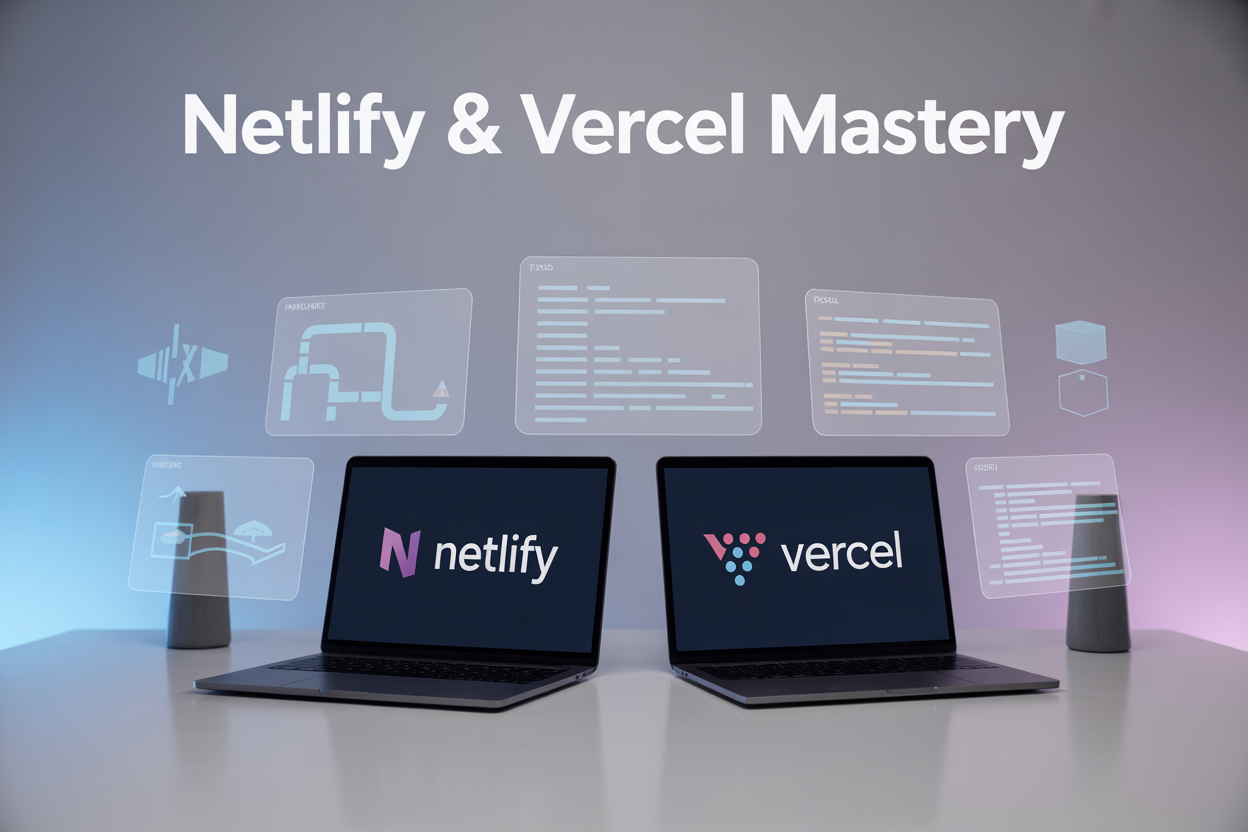Modern web deployment has transformed how developers ship applications, and Netlify and Vercel lead the pack as top hosting platforms for static sites and serverless applications. This guide targets frontend developers, full-stack engineers, and DevOps professionals who want to streamline their deployment workflows and boost site performance.
You’ll discover the key differences between Netlify vs Vercel to choose the right platform for your projects. We’ll walk through setting up bulletproof continuous deployment pipelines that automatically deploy your code changes. You’ll also learn advanced configuration techniques that maximize performance, plus how to implement serverless functions deployment for dynamic features. Finally, we’ll cover deployment troubleshooting strategies to keep your sites running smoothly.
By the end, you’ll have the skills to deploy modern web applications with confidence using these powerful platforms.
Understanding Platform Fundamentals and Core Differences

Netlify’s JAMstack-focused architecture and static site optimization
Netlify built its reputation as the go-to platform for JAMstack deployment, specializing in serving pre-built static files with lightning speed. The platform excels at transforming your source code into optimized static assets during the build process, then distributing them across a global content delivery network (CDN). This approach means your site loads incredibly fast because browsers receive pre-generated HTML, CSS, and JavaScript files rather than waiting for server-side processing.
The platform’s build system automatically handles common optimization tasks like image compression, CSS minification, and JavaScript bundling. When you push code to your connected Git repository, Netlify triggers its build environment, which can run various static site generators including Gatsby, Next.js (static export), Hugo, and Jekyll. The resulting files get deployed instantly across their edge network.
Netlify deployment shines particularly bright for content-heavy sites, portfolios, documentation, and marketing websites where content doesn’t change frequently. The platform includes built-in form handling, which converts HTML forms into serverless endpoints without requiring backend infrastructure. This makes it perfect for contact forms, newsletters, and simple data collection.
Vercel’s serverless-first approach and dynamic content handling
Vercel takes a different path, embracing serverless functions as a core feature rather than an add-on. While it handles static sites beautifully, Vercel’s architecture centers around hybrid applications that blend static generation with server-side rendering and API routes. This serverless-first mindset makes it the natural choice for applications requiring real-time data, user authentication, and dynamic content generation.
The platform’s edge runtime supports multiple programming languages including Node.js, Python, Go, and Ruby, allowing developers to create API endpoints that scale automatically. Vercel hosting excels at serving Next.js applications, offering features like incremental static regeneration (ISR) that updates static content without full rebuilds. This hybrid approach lets you serve cached static pages while still handling dynamic requests efficiently.
Vercel’s deployment pipeline integrates seamlessly with popular frameworks and provides automatic performance optimizations like edge caching, image optimization, and smart bundling. The platform’s serverless functions deployment process handles scaling automatically, spinning up resources only when needed and scaling down during low traffic periods.
Pricing models and resource allocation strategies
The pricing structures between these platforms reflect their different philosophies. Netlify offers a generous free tier including 100GB bandwidth, 300 build minutes, and basic form submissions. Their paid plans scale based on team members and additional features like split testing and advanced forms processing. Enterprise customers get priority support and enhanced security features.
| Feature | Netlify Free | Vercel Free | Netlify Pro | Vercel Pro |
|---|---|---|---|---|
| Bandwidth | 100GB | 100GB | 400GB | 1TB |
| Build minutes | 300 | 6,000 | 1,000 | 6,000 |
| Serverless functions | 125k requests | 100GB-hrs | 1M requests | 1000GB-hrs |
| Team members | Unlimited | 1 | 3 | 10 |
Vercel’s pricing focuses more on serverless execution time and bandwidth usage. Their free tier provides substantial build minutes (6,000 vs Netlify’s 300) but limits projects to personal use. The Pro tier targets individual developers and small teams, while the Team plan accommodates growing organizations with collaboration features.
Both platforms charge for overages, but their calculation methods differ. Netlify counts bandwidth and build minutes separately, while Vercel combines multiple metrics into their pricing model. For high-traffic sites, bandwidth costs can become significant on both platforms.
Performance benchmarks and speed comparisons
Real-world performance testing reveals interesting patterns between these modern web deployment platforms. Static sites typically load faster on Netlify due to their extensive CDN optimization and aggressive caching strategies. Sites serving purely static content often see sub-100ms response times globally on Netlify’s network.
Vercel demonstrates superior performance for dynamic applications, particularly those built with Next.js. Their edge network excels at serving a mix of static and server-rendered content, with intelligent caching that adapts to your application’s needs. Serverless functions on Vercel typically have lower cold start times compared to Netlify’s function execution environment.
Geographic performance varies between platforms. Netlify’s CDN performs exceptionally well in North America and Europe, while Vercel’s edge network shows more consistent global performance, particularly in Asia-Pacific regions. Both platforms offer excellent Core Web Vitals scores, but optimization approaches differ based on your application’s architecture and traffic patterns.
Build times represent another crucial performance metric. Vercel generally completes builds faster for JavaScript-heavy applications, while Netlify shows advantages for static site generators with extensive asset processing. The choice between platforms often depends on whether your application prioritizes static delivery speed or dynamic content performance.
Setting Up Your First Deployment Pipeline

Repository connection and automatic deployment configuration
Connecting your Git repository to Netlify or Vercel creates the foundation for a seamless continuous deployment pipeline. Both platforms excel at this integration, though each has its own approach to repository management.
Netlify Repository Setup:
Start by logging into your Netlify dashboard and clicking “New site from Git.” You’ll choose between GitHub, GitLab, or Bitbucket as your Git provider. After authorizing the connection, Netlify scans your repositories and lets you select the one you want to deploy. The platform automatically detects your framework and suggests build commands – pretty smart stuff.
Vercel Repository Integration:
Vercel takes a slightly different approach with their Git integration. You can connect through their dashboard or use the Vercel CLI for more control. The platform excels at detecting Next.js, React, and Vue applications automatically. Once connected, Vercel creates a webhook that triggers new deployments whenever you push to your main branch.
Branch-based Deployments:
Both platforms support branch previews, which creates unique URLs for each pull request or branch. This feature rocks for testing changes before merging to production. Configure branch deploy settings to control which branches trigger builds and which ones create preview environments.
| Feature | Netlify | Vercel |
|---|---|---|
| Auto-detection | Good for static sites | Excellent for React/Next.js |
| Branch previews | Full preview URLs | Automatic PR previews |
| Webhook customization | Advanced options | Simple configuration |
Build settings optimization for faster deployment times
Speed matters when you’re pushing multiple updates daily. Both Netlify and Vercel offer several ways to optimize your netlify deployment and vercel hosting build times without sacrificing quality.
Dependency Caching Strategies:
Enable dependency caching to avoid reinstalling packages on every build. Netlify caches node_modules automatically, but you can fine-tune this by specifying cache directories in your netlify.toml file. Vercel handles caching intelligently, storing both dependencies and build outputs between deployments.
Build Command Optimization:
Choose the right build commands for your project. Instead of running full builds every time, use incremental builds when possible. For static sites, consider using build tools like Vite or esbuild that compile faster than traditional webpack configurations.
# Optimized build commands
npm run build:fast # Skip unnecessary steps
yarn build --parallel # Use multiple cores
Resource Allocation:
Netlify offers build minute limits based on your plan, while Vercel provides generous build times even on free tiers. Monitor your build analytics to identify bottlenecks. Common performance killers include:
- Large image processing during build
- Excessive API calls at build time
- Unoptimized dependency trees
- Running tests during production builds
Selective Builds:
Configure build triggers to skip unnecessary deployments. Both platforms let you ignore builds when only documentation or non-code files change. This web deployment best practices approach saves build minutes and speeds up your development workflow.
Environment variables and secrets management
Managing environment variables properly keeps your sensitive data secure while maintaining flexibility across different deployment environments. Both platforms handle this differently, but both get the job done well.
Netlify Environment Configuration:
Navigate to Site Settings > Environment Variables in your Netlify dashboard. You can set variables for specific deploy contexts like production, branch deploys, or deploy previews. Netlify also supports scoped variables, letting you restrict certain secrets to production builds only.
The platform provides built-in variables like NETLIFY_ENV and DEPLOY_URL that help identify the current deployment context. Use these for conditional logic in your applications.
Vercel Secrets Management:
Vercel separates environment variables from secrets through their CLI and dashboard. Regular environment variables are visible in your dashboard, while secrets remain encrypted. This serverless functions deployment approach works great when you need to pass sensitive data to API routes.
# Vercel CLI commands
vercel env add PRODUCTION # Add production variable
vercel secrets add my-secret # Add encrypted secret
Best Practices for Both Platforms:
- Never commit secrets to your repository
- Use different variable names for different environments
- Regularly rotate API keys and database credentials
- Document required environment variables in your README
- Test deployments with missing variables to ensure graceful failures
Variable Precedence:
Understanding how environment variables override each other prevents deployment headaches. Both platforms follow similar patterns where build-time variables take precedence over runtime variables, and environment-specific settings override global ones.
Set up monitoring for missing or incorrect environment variables. Both platforms show build logs that help identify configuration issues before they reach production.
Advanced Configuration Techniques for Maximum Performance

Custom domain setup and SSL certificate management
Setting up custom domains on both Netlify and Vercel is refreshingly straightforward, though each platform has its unique approach. For netlify deployment, you’ll navigate to your site settings and add your domain under the “Domain settings” tab. Vercel makes it equally simple through their dashboard’s “Domains” section.
The magic happens with SSL certificates – both platforms provide automatic HTTPS with Let’s Encrypt certificates. Netlify automatically provisions SSL certificates within minutes of domain verification, while Vercel does the same with their own certificate authority. You don’t need to worry about renewal dates or manual certificate management.
Domain verification methods:
- DNS records: Add A records or CNAME records pointing to your deployment platform
- Nameserver delegation: Point your entire DNS to Netlify or Vercel’s nameservers
- External DNS: Keep your existing DNS provider and add specific records
For advanced SSL configurations, both platforms support custom certificates if you’re working with enterprise requirements or specific compliance needs.
CDN configuration and global edge network utilization
Both platforms leverage powerful global content delivery networks that automatically distribute your content across edge locations worldwide. Netlify uses their own edge network spanning over 190 locations, while Vercel partners with multiple CDN providers for their Edge Network.
The real power comes from edge-side includes and dynamic content optimization. Vercel’s Edge Functions run at the network edge, allowing you to personalize content based on user location or device type without hitting your origin server. Netlify’s Edge Handlers provide similar functionality with their distributed computing capabilities.
Performance optimization techniques:
- Asset optimization: Both platforms automatically compress images, minify CSS/JS, and optimize fonts
- Smart caching: Intelligent cache invalidation based on content changes
- Geographic routing: Serve content from the closest edge location to your users
- Preloading strategies: Prefetch critical resources based on user behavior patterns
Cache headers play a crucial role here. Set appropriate Cache-Control headers for different asset types – static assets can have longer cache times, while dynamic content needs shorter intervals.
Build optimization and dependency caching strategies
Modern web deployment hinges on efficient build processes. Both platforms offer sophisticated caching mechanisms that can dramatically reduce build times from minutes to seconds.
Netlify’s build cache automatically stores node_modules, .next folders, and other build artifacts between deployments. Their cache restoration happens before your build command runs, making subsequent builds lightning-fast. Vercel takes a similar approach but adds intelligent dependency detection – if your package.json hasn’t changed, they skip reinstalling dependencies entirely.
Build optimization checklist:
- Dependency caching: Leverage platform-specific cache directories
- Build artifact reuse: Cache compiled assets between deployments
- Parallel processing: Use build plugins that support concurrent operations
- Selective rebuilds: Only rebuild changed components in monorepo setups
For netlify configuration, you can customize caching behavior through your netlify.toml file. Vercel users can define caching strategies in their vercel.json configuration. Both platforms support custom build commands and environment-specific optimizations.
Consider implementing build matrices for different environments – development builds can skip optimization steps that production requires, while staging environments might need different caching strategies than production deployments.
Preview deployments and branch-based workflows
Preview deployments transform how teams collaborate on web projects. Every pull request automatically generates a unique URL where stakeholders can review changes before they go live. This branch-based workflow eliminates the “works on my machine” problem and enables better quality assurance.
Netlify creates deploy previews for every branch push, generating unique URLs that persist until the branch is deleted. Vercel’s preview deployments work similarly but add comment integration – team members can leave feedback directly on preview URLs, creating a seamless review process.
Branch workflow strategies:
- Feature branches: Each feature gets its own preview URL for isolated testing
- Environment parity: Preview deployments mirror production configuration
- Collaborative review: Share preview links with designers, stakeholders, and clients
- Automated testing: Run integration tests against preview deployments
Both platforms integrate beautifully with GitHub, GitLab, and Bitbucket. Webhooks trigger new builds automatically when code changes, while status checks prevent merging broken code. You can configure deployment contexts to handle different environments – development, staging, and production can each have their own build settings and environment variables.
Preview deployments also excel at A/B testing scenarios. Deploy different versions to separate branches, then compare performance metrics and user engagement across variations. This approach works particularly well for jamstack deployment scenarios where static generation enables quick iterations.
The key to maximizing these workflows lies in proper branch protection rules and deployment policies. Set up your repositories so that only tested, approved changes make it to your main branch, while keeping the feedback loop tight through instant preview generation.
Implementing Serverless Functions and API Routes

Function deployment and cold start optimization
Serverless functions deployment on both Netlify and Vercel requires careful consideration of runtime environments and optimization strategies. When deploying serverless functions, choose your runtime wisely – Node.js typically offers the best cold start performance, while Python and Go provide excellent execution speed once warmed up.
Cold start optimization becomes critical for user experience. Bundle your functions efficiently by keeping dependencies minimal and using tree-shaking to eliminate unused code. Vercel’s Edge Functions run closer to users globally, reducing latency significantly compared to traditional serverless functions. For Netlify, leverage their Background Functions for long-running processes that don’t need immediate responses.
Memory allocation directly impacts both cold start times and execution performance. Start with 512MB for most functions, then adjust based on actual usage patterns. Higher memory allocation provides more CPU power but costs more and may increase cold starts for infrequently accessed functions.
Pre-warming strategies work differently across platforms. Vercel automatically keeps frequently accessed functions warm, while Netlify requires scheduled functions or external services to maintain warmth. Consider implementing connection pooling and keeping database connections alive between invocations to reduce initialization overhead.
Database integration and connection pooling
Database connections in serverless environments present unique challenges since functions don’t maintain persistent connections. Traditional connection patterns break down when each function invocation potentially creates new database connections, quickly exhausting connection pools.
Connection pooling becomes essential for serverless functions deployment. Use connection poolers like PgBouncer for PostgreSQL or implement application-level pooling with libraries such as @vercel/postgres or @supabase/supabase-js. These tools manage connection lifecycle automatically and prevent connection exhaustion.
| Platform | Recommended Pooling Strategy | Max Connections |
|---|---|---|
| Netlify | External pooler (PgBouncer) | 20-50 per function |
| Vercel | Built-in Vercel Postgres | 100+ concurrent |
| Both | Prisma with connection pooling | 10-20 per function |
Environment-specific database configurations require different approaches. Development environments can use direct connections, while production should always use pooled connections. Store connection strings securely using platform-specific environment variables – Netlify’s site settings or Vercel’s project dashboard.
Implement proper connection cleanup and error handling. Close connections explicitly in function cleanup, and implement retry logic for transient connection failures. Monitor connection usage through your database provider’s dashboard to identify potential bottlenecks.
Authentication and security implementation
Authentication patterns for serverless functions require stateless approaches since functions don’t maintain session state between invocations. JSON Web Tokens (JWT) work perfectly for this architecture, allowing functions to verify user identity without database lookups on every request.
API key management becomes straightforward with both platforms’ environment variable systems. Store sensitive keys using encrypted environment variables, and implement key rotation strategies for production applications. Netlify and Vercel both support different environment scopes – development, preview, and production.
CORS configuration needs special attention in serverless functions deployment scenarios. Both platforms handle CORS differently – Vercel requires explicit headers in function responses, while Netlify offers built-in CORS handling through netlify.toml configuration.
Rate limiting implementation varies by platform. Vercel Pro plans include built-in rate limiting, while Netlify requires custom implementation or third-party services. Implement rate limiting at the function level using in-memory stores or external services like Redis for distributed rate limiting.
Security headers should be implemented consistently across all functions. Set appropriate Content Security Policy headers, implement HTTPS enforcement, and validate all input data. Both platforms provide security scanning, but manual security reviews remain essential for production deployments.
Input validation becomes critical since serverless functions often serve as API endpoints. Implement schema validation using libraries like Joi or Zod, and sanitize all user inputs before processing. Log security events appropriately while avoiding logging sensitive data like passwords or API keys.
Monitoring and Troubleshooting Deployment Issues

Analytics Dashboard Utilization and Performance Tracking
Both Netlify and Vercel provide comprehensive analytics dashboards that give you deep insights into your deployment performance. Netlify’s analytics dashboard shows real-time traffic patterns, bandwidth usage, and form submissions, while Vercel’s dashboard focuses on function execution times, edge network performance, and core web vitals.
The key metrics to monitor include:
- Page load times across different geographical regions
- Build duration and deployment frequency
- Bandwidth consumption and traffic spikes
- Function invocation counts and execution duration
- Error rates and status code distributions
Set up custom alerts for performance thresholds that matter to your application. For example, configure notifications when build times exceed 5 minutes or when error rates climb above 2%. Both platforms integrate seamlessly with third-party monitoring tools like DataDog, New Relic, and Google Analytics for more granular tracking.
Use the built-in Real User Monitoring (RUM) data to identify performance bottlenecks. Vercel’s Edge Network analytics help pinpoint which regions experience slower response times, while Netlify’s bandwidth analytics reveal which assets consume the most resources.
Error Logging and Debugging Deployed Applications
Effective error logging starts with proper configuration in your deployment settings. Netlify automatically captures build logs and function errors, storing them in the deploy log section of your dashboard. Access these logs through the site dashboard or via the Netlify CLI using netlify logs.
Vercel provides function logs through their dashboard and CLI with vercel logs. For React applications deployed on Vercel, enable error reporting by adding error boundaries and integrating with services like Sentry or LogRocket.
Common debugging strategies include:
- Source map configuration for meaningful stack traces
- Environment variable validation in serverless functions
- CORS policy verification for API route issues
- Build dependency analysis for deployment failures
Enable verbose logging in your build scripts to capture detailed information during the deployment process. Add custom logging statements in your serverless functions to track request flows and identify where failures occur.
For debugging deployment troubleshooting issues, check the build logs first, then examine function execution logs, and finally review network requests in your browser’s developer tools.
Rollback Procedures and Version Control Management
Both platforms maintain deployment history, making rollbacks straightforward when issues arise. Netlify stores up to 100 previous deployments by default, while Vercel keeps deployment history based on your plan limits.
Quick rollback procedures:
| Platform | Method | Command |
|---|---|---|
| Netlify | Dashboard | Click “Publish deploy” on previous version |
| Netlify | CLI | netlify sites:list then netlify api rollbackSiteDeploy |
| Vercel | Dashboard | Select previous deployment and promote |
| Vercel | CLI | vercel rollback [deployment-url] |
Implement proper version control management by:
- Tagging releases in your Git repository
- Creating deployment branches for staging environments
- Using semantic versioning for tracking changes
- Documenting rollback reasons in commit messages
Set up automated rollback triggers based on health checks. Configure monitoring that automatically reverts to the previous deployment if error rates exceed acceptable thresholds or if core functionality becomes unavailable.
Load Testing and Scalability Planning
Proper load testing prevents performance surprises when traffic spikes occur. Both Netlify and Vercel handle traffic scaling automatically, but understanding your limits helps with capacity planning.
Load testing tools and approaches:
- Artillery.io for API endpoint testing
- k6 for comprehensive load testing scenarios
- WebPageTest for front-end performance under load
- Apache Bench (ab) for simple HTTP load testing
Test different scenarios including:
- Sudden traffic spikes (10x normal load)
- Sustained high traffic over extended periods
- Function cold starts and warm-up times
- Database connection limits for dynamic applications
Monitor function execution limits on both platforms. Netlify provides 125,000 function invocations per month on the free tier, while Vercel offers 100GB-hours of function execution time. Plan your architecture accordingly and consider implementing caching strategies to reduce function calls.
Scale testing should include edge case scenarios like file upload limits, form submission rates, and concurrent user sessions. Document your findings and create runbooks for handling traffic surges, including when to upgrade plans or implement additional caching layers.

Both Netlify and Vercel offer powerful solutions for modern web deployment, each with unique strengths that can transform how you ship applications. The key lies in understanding their core differences, setting up robust deployment pipelines, and leveraging advanced configurations to squeeze out every bit of performance. When you combine these practices with serverless functions and solid monitoring strategies, you’re building on a foundation that scales with your needs.
Don’t get caught up in the platform wars – pick the one that aligns with your project requirements and team workflow. Start with the basics, deploy something simple, then gradually explore the advanced features as your confidence grows. The web development landscape moves fast, but mastering these deployment platforms gives you the stability and flexibility to adapt to whatever comes next. Your users will thank you for the lightning-fast load times, and your team will appreciate the smoother development experience.




















